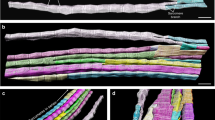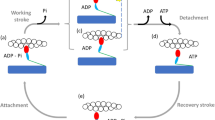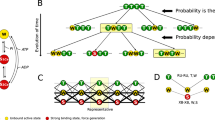Abstract
IT has long been assumed that an elastic component other than extracellular collagen fibres is present in muscle fibres to explain their elastic properties, especially during passive stretch1,2 The presence of such an elastic component has been demonstrated in skinned fibres of frog skeletal muscle3,4. Furthermore, it has been observed that myofibrils after the removal of myosin are reversibly extended, indicating their structural continuity5. The chemical entity responsible for the intracellular elasticity of muscle has, however, remained obscure. When rabbit myofibrils were thoroughly extracted with salt solutions such as 0.6 M KI, it was noticed that remaining Z lines still maintained their continuity, although nothing could be seen between the adjacent Z lines under a phase microscope (compare ref. 6). Starting from this observation, we have been able to isolate an elastic protein from myofibrils which is clearly distinguishable from elastin or collagen.
This is a preview of subscription content, access via your institution
Access options
Subscribe to this journal
Receive 51 print issues and online access
$199.00 per year
only $3.90 per issue
Buy this article
- Purchase on Springer Link
- Instant access to full article PDF
Prices may be subject to local taxes which are calculated during checkout
Similar content being viewed by others
References
Casella, C., Acta physiol. scand., 21, 380–401 (1950).
Buchtal, F., and Weis-Fogh, T., Acta physiol. scand., 35, 345–364 (1956).
Natori, R., Jikeikai Med. J., 1, 18–28 (1954).
Matsubara, S., Jap. J. Physiol., 25, 227–240 (1975).
Huxley, H. E., and Hanson, J., Nature, 173, 971–973 (1954).
Huxley, H. E., and Hanson, J., Biochim. biophys. Acta, 23, 229–249 (1957).
Perry, S. V., and Grey, T. C., Biochem. J., 64, 184–192 (1956).
Saide, J. D., and Ullrick, W. C., J. molec. Biol., 87, 671–683 (1974).
Maruyama, K., J. Biochem. Tokyo, 69, 369–386 (1971).
Partridge, S. M., and Davis, H. F., Biochem. J., 61, 21–30 (1955).
Bailey, K., and Weis-Fogh, T., Biochim. biophys. Acta, 48, 452–459 (1961).
Seifter, S., and Gallop, P. M., in The Proteins, 2nd ed., 4, (edit. by Neurath, H.), 153–458 (Academic, New York, 1966).
Pras, M., and Glynn, L. E., Br. J. exp. Path., 54, 449–456 (1973).
Pras, M., Johnson, G. D., Holborow, E. J., and Glynn, L. E., Immunology, 27, 469–478 (1974).
Author information
Authors and Affiliations
Rights and permissions
About this article
Cite this article
MARUYAMA, K., NATORI, R. & NONOMURA, Y. New elastic protein from muscle. Nature 262, 58–60 (1976). https://doi.org/10.1038/262058a0
Received:
Accepted:
Issue Date:
DOI: https://doi.org/10.1038/262058a0
This article is cited by
-
Preservation of shortening velocity and power output in single muscle fibres from patients with idiopathic inflammatory myopathies
Journal of Muscle Research and Cell Motility (2023)
-
Mechanisms of Frank-Starling law of the heart and stretch activation in striated muscles may have a common molecular origin
Journal of Muscle Research and Cell Motility (2021)
-
Force enhancement after stretch of isolated myofibrils is increased by sarcomere length non-uniformities
Scientific Reports (2020)
-
Calcium-dependent titin–thin filament interactions in muscle: observations and theory
Journal of Muscle Research and Cell Motility (2020)
-
Effects of S-glutathionylation on the passive force–length relationship in skeletal muscle fibres of rats and humans
Journal of Muscle Research and Cell Motility (2020)
Comments
By submitting a comment you agree to abide by our Terms and Community Guidelines. If you find something abusive or that does not comply with our terms or guidelines please flag it as inappropriate.



